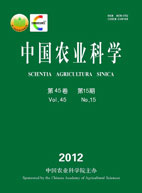-
Effects of Exogenous Nitric Oxide on Growth, Antioxidant System and Photosynthetic Characteristics in Seedling of Cotton Cultivar Under Chilling Injury Stress
- YANG Mei-Sen, WANG Ya-Fang, GAN Xiu-Xia, LUO Hong-Hai, ZHANG Ya-Li, ZHANG Wang-Feng
-
Scientia Agricultura Sinica. 2012, 45(15):
3058-3067.
doi:10.3864/j.issn.0578-1752.2012.15.006
-
 Abstract
(
908 )
Abstract
(
908 )
 PDF (590KB)
(
1061
)
PDF (590KB)
(
1061
)
 Save
Save
-
References |
Related Articles |
Metrics
【Objective】Cotton is a typical thermophilic crop. It is sensitive to low temperature stress, cold stress influenced greatly on cotton production, so it is of much improtance to explore the effects of exogenous NO donor (SNP) on cotton resistance ability.【Method】‘Xinluzao 13’ and ‘Xinluzao 33’ were used as materials in this experiment to investigate the effect of SNP(100 μmol•L-1) on growth, chlorophyll content, gas exchange parameters, cholorophyll fluorescence parameters and active oxygen metabolism in seedlings of cotton cultivar under chilling stress.【Result】 It was found that SNP had no significant influence on growth, H2O2, Pro, soluble protein and SOD, but improved the activities of POD, CAT, APX and GR significantly under normal growth conditions. SNP had no obvious influence on chlorophyll content, Pn, Ci, F0 and Fv/Fm, but increased Gs, Tr, ETR and ΦPSⅡ significantly. Under chilling stress, exogenous NO treatments significantly increased the growth rate, SOD, POD, CAT, APX and GR activities of leaves, but reduced H2O2 and MDA contents. Exogenous NO increased chlorophyll content, Pn, Gs, Tr, Fv/Fm, ETR and ΦPSⅡ, reduced Ci but increased NPQ, avoided excessive light damage and maintained higher PSⅡ activity.【Conclusion】Under chilling stress, exogenous NO application reduced the accumulation of H2O2 and MDA, and protected the stabilization of membrane via enhancing the antioxidant enzymes activities and the contents of antioxidants, and enhanced cold tolerance in cotton seedlings and alleviated chilling stress damage to PSII center.









